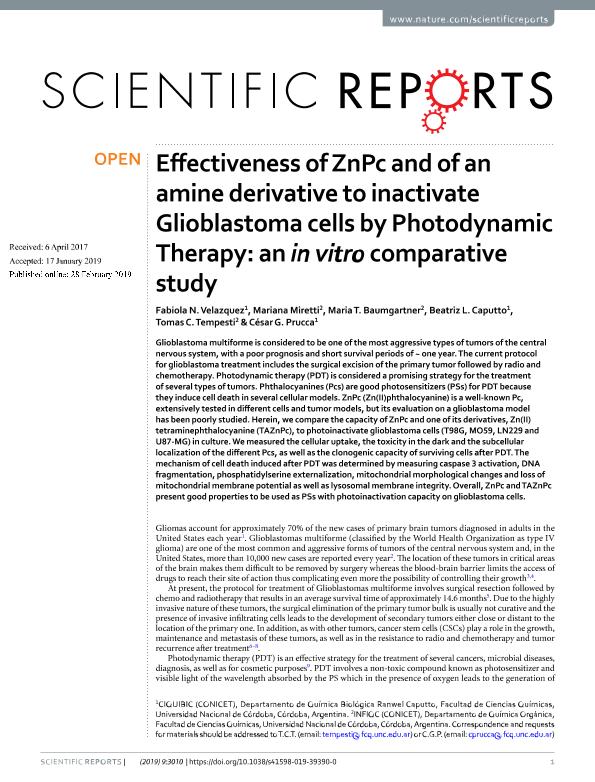Mostrar el registro sencillo del ítem
dc.contributor.author
Velazquez, Fabiola Noelia

dc.contributor.author
Miretti, Mariana

dc.contributor.author
Baumgartner, Maria Teresa del V.

dc.contributor.author
Caputto, Beatriz Leonor

dc.contributor.author
Tempesti, Tomas Cristian

dc.contributor.author
Prucca, César G.
dc.date.available
2020-12-09T20:04:31Z
dc.date.issued
2019-12
dc.identifier.citation
Velazquez, Fabiola Noelia; Miretti, Mariana; Baumgartner, Maria Teresa del V.; Caputto, Beatriz Leonor; Tempesti, Tomas Cristian; et al.; Effectiveness of ZnPc and of an amine derivative to inactivate Glioblastoma cells by Photodynamic Therapy: An in vitro comparative study; Nature Publishing Group; Scientific Reports; 9; 1; 12-2019; 1-15
dc.identifier.uri
http://hdl.handle.net/11336/120034
dc.description.abstract
Glioblastoma multiforme is considered to be one of the most aggressive types of tumors of the central nervous system, with a poor prognosis and short survival periods of ~ one year. The current protocol for glioblastoma treatment includes the surgical excision of the primary tumor followed by radio and chemotherapy. Photodynamic therapy (PDT) is considered a promising strategy for the treatment of several types of tumors. Phthalocyanines (Pcs) are good photosensitizers (PSs) for PDT because they induce cell death in several cellular models. ZnPc (Zn(II)phthalocyanine) is a well-known Pc, extensively tested in different cells and tumor models, but its evaluation on a glioblastoma model has been poorly studied. Herein, we compare the capacity of ZnPc and one of its derivatives, Zn(II)tetraminephthalocyanine (TAZnPc), to photoinactivate glioblastoma cells (T98G, MO59, LN229 and U87-MG) in culture. We measured the cellular uptake, the toxicity in the dark and the subcellular localization of the different Pcs, as well as the clonogenic capacity of surviving cells after PDT. The mechanism of cell death induced after PDT was determined by measuring caspase 3 activation, DNA fragmentation, phosphatidylserine externalization, mitochondrial morphological changes and loss of mitochondrial membrane potential as well as lysosomal membrane integrity. Overall, ZnPc and TAZnPc present good properties to be used as PSs with photoinactivation capacity on glioblastoma cells.
dc.format
application/pdf
dc.language.iso
eng
dc.publisher
Nature Publishing Group
dc.rights
info:eu-repo/semantics/openAccess
dc.rights.uri
https://creativecommons.org/licenses/by-nc-sa/2.5/ar/
dc.subject
Glioblastoma
dc.subject
Photodynamic therapy
dc.subject
Zn phthalocyanines
dc.subject.classification
Otras Ciencias Biológicas

dc.subject.classification
Ciencias Biológicas

dc.subject.classification
CIENCIAS NATURALES Y EXACTAS

dc.title
Effectiveness of ZnPc and of an amine derivative to inactivate Glioblastoma cells by Photodynamic Therapy: An in vitro comparative study
dc.type
info:eu-repo/semantics/article
dc.type
info:ar-repo/semantics/artículo
dc.type
info:eu-repo/semantics/publishedVersion
dc.date.updated
2020-11-17T18:32:26Z
dc.identifier.eissn
2045-2322
dc.journal.volume
9
dc.journal.number
1
dc.journal.pagination
1-15
dc.journal.pais
Reino Unido

dc.journal.ciudad
Londres
dc.description.fil
Fil: Velazquez, Fabiola Noelia. Consejo Nacional de Investigaciones Científicas y Técnicas. Centro Científico Tecnológico Conicet - Córdoba. Centro de Investigaciones en Química Biológica de Córdoba. Universidad Nacional de Córdoba. Facultad de Ciencias Químicas. Centro de Investigaciones en Química Biológica de Córdoba; Argentina
dc.description.fil
Fil: Miretti, Mariana. Consejo Nacional de Investigaciones Científicas y Técnicas. Centro Científico Tecnológico Conicet - Córdoba. Instituto de Investigaciones en Físico-química de Córdoba. Universidad Nacional de Córdoba. Facultad de Ciencias Químicas. Instituto de Investigaciones en Físico-química de Córdoba; Argentina
dc.description.fil
Fil: Baumgartner, Maria Teresa del V.. Consejo Nacional de Investigaciones Científicas y Técnicas. Centro Científico Tecnológico Conicet - Córdoba. Instituto de Investigaciones en Físico-química de Córdoba. Universidad Nacional de Córdoba. Facultad de Ciencias Químicas. Instituto de Investigaciones en Físico-química de Córdoba; Argentina
dc.description.fil
Fil: Caputto, Beatriz Leonor. Consejo Nacional de Investigaciones Científicas y Técnicas. Centro Científico Tecnológico Conicet - Córdoba. Centro de Investigaciones en Química Biológica de Córdoba. Universidad Nacional de Córdoba. Facultad de Ciencias Químicas. Centro de Investigaciones en Química Biológica de Córdoba; Argentina
dc.description.fil
Fil: Tempesti, Tomas Cristian. Consejo Nacional de Investigaciones Científicas y Técnicas. Centro Científico Tecnológico Conicet - Córdoba. Instituto de Investigaciones en Físico-química de Córdoba. Universidad Nacional de Córdoba. Facultad de Ciencias Químicas. Instituto de Investigaciones en Físico-química de Córdoba; Argentina
dc.description.fil
Fil: Prucca, César G.. Consejo Nacional de Investigaciones Científicas y Técnicas. Centro Científico Tecnológico Conicet - Córdoba. Centro de Investigaciones en Química Biológica de Córdoba. Universidad Nacional de Córdoba. Facultad de Ciencias Químicas. Centro de Investigaciones en Química Biológica de Córdoba; Argentina
dc.journal.title
Scientific Reports
dc.relation.alternativeid
info:eu-repo/semantics/altIdentifier/url/http://www.nature.com/articles/s41598-019-39390-0
dc.relation.alternativeid
info:eu-repo/semantics/altIdentifier/doi/https://doi.org/10.1038/s41598-019-39390-0
Archivos asociados
